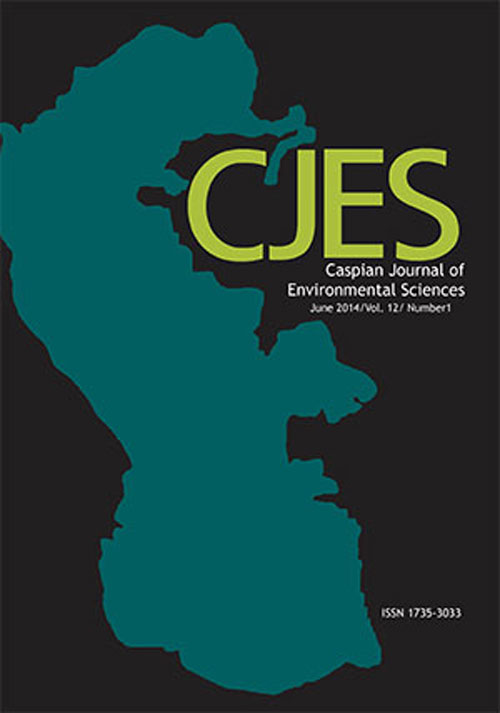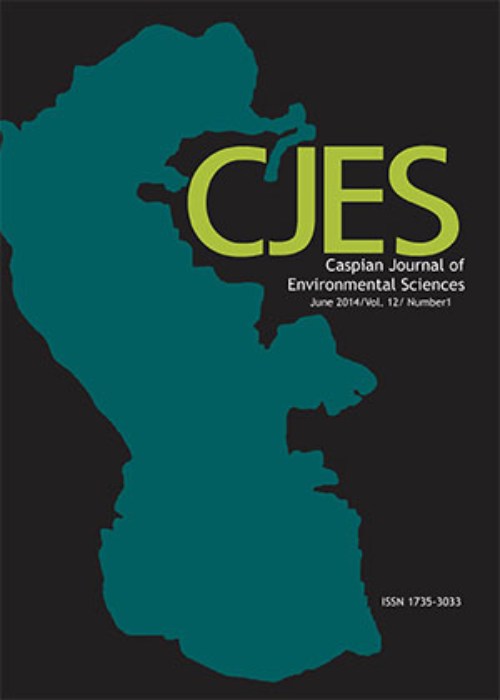فهرست مطالب

Caspian Journal of Environmental Sciences
Volume:18 Issue: 2, Spring 2020
- تاریخ انتشار: 1399/02/16
- تعداد عناوین: 8
-
-
Pages 97-107
Investigating the factors affecting CO2 emissions has always been a challenge. One problem with existing studies is that these studies have been relied on mean-based regression approaches, such as ordinary least squares (OLS) or instrumental variables, which implicitly assumes that the impact of variables along the distribution of CO2 emissions is the same. Unlike previous studies, the present study will use the quantile regression developed by Koenker & Bassett, which is not limited to the assumption. So that, the purpose of this study is to investigate the impacts of technological innovation and renewable energy on CO2 emissions in selected countries of the International Renewable Energy Agency (IRENA) using quantile regression over the period 1990-2016. The results of this study exhibited that the impact of renewable energy on CO2 emissions was negative and statistically significant. This impact is also enhanced in high quantiles (countries with high pollution). In all the studied quantiles, the impact of technological innovations on CO2 emissions was positive, significant and initially decreasing, while increasing again over time. The results of the symmetry test also indicated that by increasing in the volume of CO2 emissions, the variable impact of renewable energy upraised. However, no incremental trend was observed in innovation.
Keywords: Technological innovation, Renewable energy, Environmental pollution, Quantile -
Pages 109-122
This research was conducted to present an integrated rainfall-runoff model based on the physical characteristics of the watershed, and to predict discharge not only in the outlet, but also at any desired point within the basin. To achieve this goal, a matrix of hydro-climatic variables (i.e. daily rainfall and daily discharge) and geomorphologic characteristics such as upstream drainage area (A), mean slope of watershed (S) and curve number (CN) was designed and simulated using artificial intelligence techniques. Integrated Geomorphology-based Artificial Neural Network (IGANN) model with Root Mean Squared Error (RMSE) of 0.02786 m3 s-1 and Nash-Sutcliffe Efficiency (NSE) of 0.9403 and Integrated Geomorphology-based Adaptive Neuro-Fuzzy Inference System (IGANFIS) model with RMSE of 0.02795 m3 s-1 and NSE of 0.94467 were able to predict the discharge values of all hydrometric stations of the Chalus River watershed with a very low error and high accuracy. The results of cross validation stage confirmed the efficiency of models. Hydro-climatic variables and geomorphologic parameters selected in the study were: discharge of one day ago, discharge of two days ago, rainfall of current day and rainfall of one day ago and S, CN and A, respectively. In addition, the IGANN model shows superiority compared with the IGANFIS model.
Keywords: Physical characteristics of watershed, Rainfall-runoff modeling, Black box modeling, Artificial intelligence, Geomorphologic unit hydrograph -
Pages 123-130
This study is to provide information on levels of the elements in leaves and roots-rhizomes of Zostera marina and Zostera noltei, their surrounding sea water and sediments collected from Akliman and Türkeli coastal areas of Sinop city in the Black Sea four times between September 2015 and July 2016. The concentrations of Al, Mn, Fe, Co, Ni, Cu, Zn, As, Cd, Hg and Pb in digested samples were measured by Agilent Technologies, 7700X ICP-MS (inductively coupled plasma mass spectrometer). The results showed that the concentrations of metals were found in the order Hg < Cd < Co < As < Pb < Ni < Cu < Zn < Mn < Al = Fe. Zostera species were bio-accumulative for Al and Mn (BCF ≥ 5000); and macro-consantrator for Zn and Cd (BSAF > 2). The general capacities of element translocation were found as acropetal for Al, Mn, Ni, Cd and Hg in eelgrass. The present findings interpreted for the first time in the Turkish Black Sea waters. Both species of Zostera in high concentrations of these elements may be due to untreated wastes that are discharging from different sources such as harbor activities, agricultural and domestic wastes in coastal areas. In order to assess the impact of contaminants and take necessary actions, the region needs to be monitored regularly.
Keywords: Zostera marina, Zostera (Zosterella) noltei, Black Sea, Sinop coasts, Contaminants -
Pages 131-147
The humans have the capacity to transmit knowledge to other individuals remote in space and time by verbal and written means. Ethno-pharmacology is based on approaches from the sociocultural and natural sciences. Ethnobotanical research in the Talassemtane National Park was undertaken following a perspective to establish the base of comparative study with Andalusian and Sicilian regions. The aim of these studies was to analyze the data regarding interviewees (socio-demographic), status, perception of inhabitants of the Northern Morocco, confidence in the healing properties of medicinal plants, and conserving the traditional medicinal heritage of the Talassemtane National Park (TLSNP). This study was conducted in the National Park of Talassemtane for a three-year survey (2014-2017). In total, 200 local traditional informers were interviewed to explore the traditional ethnobotanical and ethno-pharmacological knowledge of the local population. Information was collected using open-ended and semi-structured interviews, followed by the analysis of data regarding the interviewees (socio-demographic) and the ethnobotanical or ethno-pharmacological data. In this study, we have identified a total of 152 medicinal plant species belonging to 44 botanical families. The most important family is that of the Apiaceae represented by 31 species. We identified 567 symptoms and diseases for the 152 taxa belonging to 44 included families, with a total of 9402 use reports (UR). They are used to treat up to 123 conditions or symptoms classified into 15 pathological groups according to the ICPC-2 classification of diseases. Concerning the diseases, the main pathological group treated is the one for digestive symptoms (D, 24%). The results show that 50 % of the local population still prefer to use traditional medicine for daily healthcare, and a few of them support these traditional medicines along with conventional drugs. The analysis of data obtained in this ethnobotanical study allowed us to identify the most commonly used medicinal plants in the TLSNP. The knowledge reported in this study is a very original source of information on the local traditional medical flora and provide an additional value to the emblematic Talassemtane National Park.
Keywords: Ethnobotanical approach, Medicinal plants, traditional medicine, Talassemtane National Park, North of Morocco -
Pages 149-156Purpose
The objective of this paper is to make an investigation of spread of novel coronavirus (COVID-19) in MOROCCO and to estimate the duration of confinement for the fight against coronavirus disease 2019 (COVID -19).
MethodsData available on the sites provided by the Moroccan Ministry of Health, nonlinear regression, Gaussian function, residual sum of squares and regression curve.
ResultsMoroccan citizens must stay at home as much as possible until June 12, 2020.
ConclusionGiven the non-existence of a vaccine or an effective treatment against the coronavirus (COVID-19), our research team believes that confinement remains the best solution to limit the spread of this pandemic.
Keywords: Pandemic, COVID-19, Investigation, Confinement -
Pages 157-170
This research aimed to investigate the relationship between plant composition of Dinarkooh Protected Area (DPA), west of Iran (called Zagros forests) with elevation and soil properties. A total of 100 random sampling plots (25 × 25 m) at different elevations were sampled for their soil and collection of plant specimens and vegetation data based on Braun-Blanquet covered-abundance scale. Data were analyzed using TWINSPAN and multivariate statistical analysis packages. We recognized 142 plant species present in the study area identified under 105 genera and 29 families. Asteraceae, Papilionaceae and Poaceae were the most frequently encountered families. Bromus and Astragalus were also the largest genera in the study area. The plant species were grouped into three ecological groups based on elevation and soil properties: Group 1 with 20 species including Scorzonera sp. and Cerastium inflatum L. at lower elevation (1300-1500 m a.s.l.) and with clay-loam soil; Group 2 with 96 species, including Onosma trachytrichum Boiss., Eryngium noeanum Boiss. and Acer monspessulanum L. occurred at middle elevations with alkaline loam-clay soil; and Group 3 with 26 species, including Bromus sterilis L., Minuartia meyeri, Minuartia meyeri (Boiss.) Bornm., Lithospermum sp., Scariola orientalis (Boiss.) Sojak and Trifolium tomentosum L. at higher elevation with sandy-loam soil. Prevalent tree species included Oak (Quercus brantii Lindl. var. persica (Jaub. & Spach)) in Group 2 and Acer monspessulanum L. in Group 3. Low homogeneity of plant compositions at different elevations reflects the differences in habitat properties. Results showed that the elevation and soil properties played primary and complementary roles in vegetation spatial composition. Furthermore, diversity and richness of plant species was higher at middle elevations. More detailed investigation into biotic variables at the root level would complement current data to analyze this ecosystem.
Keywords: Zagros forests, Dinarkooh, Ecological species group, Environmental factors, Multivariate analysis -
Pages 171-179
Horizontal cypress is an endemic conifer species of Hyrcanian forest which grows in special sites with Mediterranean climate in this area. The study was conducted to evaluate the effect of irrigation, seed source, growing media, and sowing time on seed germination of horizontal cypress in the Pilembera nursery located in West Guilan Province. The seeds were collected from three different seed sources in west (Roodbar), middle (Hassanabad), and east (Aliabad) of Hyrcanian forests. Seeds were sown in two different times (February and March) in four soil compositions (different combinations of soil, manure, and sand), irrigated by three different periods (every day, every three days, every five days), in a complete randomized block designs. The results showed maximum seed germination and highest seedlings height in Hassanabad and Aliabad which were sown in March in pots containing soil mixed with manure, irrigated every day. According to the results, successful seedling production of horizontal cypress is highly depends on seed origins and seed sowing time.
Keywords: Seed germination, Cypress, Nursery, Iran -
Pages 181-192
The present paper aims to determine the effects of various scenarios of green tax burden on pollution dispersion and multiple macro-economic variables such as GDP along with welfare and inflation. In addition, the effects of technical progress on major pollutant industries such as coal, oil and gas were evaluated. For this purpose general multiregional equilibrium method (GTAP-E) was used. The results of the study indicated that under low tax rate scenario, GDP remained unchanged. Increase in the carbon tax rate would not followed by increase in GDP. Energy consumption and social welfare increased but inflation decreased. Furthermore, increase in efficiency along with advance technology caused reduction in dispersion of environmental pollutants along with GDP growth and consequent increase in government tax revenue.
Keywords: Environmental CGE model, carbon tax rate, Energy Consumption, CO2 emissions, Multi-Regional General Equilibrium Model GTAP)


